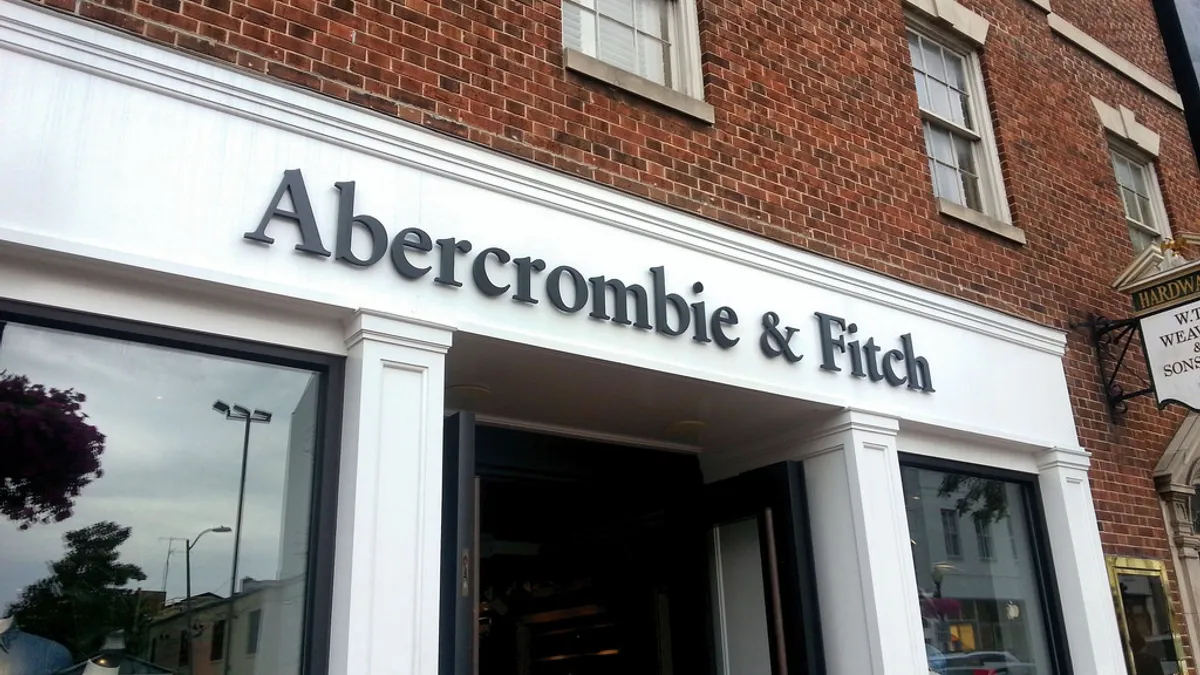Dive Brief:
-
UPDATE: Abercrombie & Fitch Co. announced on Wednesday that it "is in preliminary discussions with several parties regarding a potential transaction with the company," according to a company press release, which clarifies there is no guarantee the talks will lead to any definitive agreement.
-
UPDATE: The company has reportedly hired investment bank Perella Weinberg Partners to review takeover bids from at least two suitors — American Eagle Outfitters and Express — unnamed sources told The Wall Street Journal Wednesday. Spokespeople from Abercrombie and Express declined to comment to the Journal and American Eagle did not immediately respond.
-
In February, the company promoted Fran Horowitz to CEO; as president and chief merchandising officer, she led the turnaround of the teen apparel retailer’s better-performing Hollister brand. At the start of the year, after a rough holiday season, the retailer laid off 150 of its 2,200 workers at its New Albany, OH headquarters.
Dive Insight:
The faltering teen retailer, which still retains a valuable brand, is piquing the interest of rival apparel retailers. While both Express and American Eagle may see an opportunity in Abercrombie to broaden their customer bases, both are feeling the effects of a culling in the junior apparel sector, sparked by falling foot traffic at malls and changing consumer behavior toward online purchasing.
Just last week, Express announced it would shutter all of its Canadian operations amid a “challenging Canadian retail environment;” and the company isn’t faring much better in the U.S. Fourth quarter net sales fell 11% to $678.8 million from $765.6 million in the year-ago quarter. Same-store sales fell 13% in Q4 2016, and e-commerce sales rose 9% to $170.1 million, accounting for 25% of net sales in the quarter.
Meanwhile, American Eagle is forecasting flat fiscal 2017 same-store sales, although it is being buoyed somewhat by its popular Aerie lingerie brand, which garnered a 17% rise in same-store sales, compared to a 1% same-store decline in the rest of the retailer’s brands.
Abercrombie & Fitch — which has enjoyed ardor overseas that never cooled quite as much as it did in the U.S. — has been working to solidify its presence in Asia. Last month, the retailer entered into a wholesale agreement with Zalora, a major fashion e-commerce company based in Singapore and operating in six markets, including Singapore, Hong Kong, Taiwan, Malaysia, Indonesia and the Philippines. Zalora, which has captured the attention of millions of Southeast Asian shoppers since launching five years ago, is a good choice of partner. Zalora earlier inked a similar deal with Topshop.
Back home, however, Abercrombie & Fitch's investments continue to fall flat. The recovery that seemed nascent in 2015 and continued in 2016 has devolved into a significant slump. The struggling teen apparel retailer in March announced plans to shutter 60 U.S. stores as leases expire. Last year, the company closed 54 stores, mostly in the U.S.
The company’s fourth quarter same-store sales fell 5% and Q4 net sales fell 7% to $1.036 billion. However, direct-to-consumer and omnichannel sales grew to 31% of total company net sales, compared to 28% in the year-ago quarter. For the full year, the category grew to 26% of total company net sales, up from 24%. Abercrombie's more youthful Hollister surf brand (the first emissary in its Zalora launch) generated uplift as well: While Q4 same-store sales at the flagship Abercrombie brand dropped 13%, Hollister posted a 1% increase in the period, its first in a year. The teen apparel retailer will announce its first quarter earnings on May 25.
Moody's Investors Service recently downgraded Abercrombie due to significant earnings declines and expects the retailer to show modestly lower results over the next year, Moody's Vice President and Senior Analyst Raya Sokolyanska said in a statement emailed to Retail Dive. "Even for retailers with no immediate financial pressures, consolidation provides much needed cost saving opportunities amid declining traffic, heavy promotions and weak teen spending on apparel," she said. "For Abercrombie & Fitch, a merger with the right strategic buyer can also strengthen marketing, product and digital capabilities, especially given the difficulty turning around the Abercrombie brand."
In February, Abercrombie unveiled its first new store concept in more than 15 years, after taking time to make good on repeated promises to turn up the lights at its darkly-lit, heavily-perfumed stores — an approach held over from the tenure of CEO Mike Jeffries, who created an exclusive ethos catering to some mythic cool kid. That fell out of favor long ago — but the retailer has struggled with attempts to rebrand.
While Hollister's California surf vibe seems to have some traction, the flagship’s changes so far haven’t resonated with the fickle teen demographic. Some observers are questioning its merchandising and marketing pivot to appeal to an older consumer, presumably one with more money to spend. Eric Beder of Wunderlich Securities wrote in a note last fall that marketing to an older age group "makes little sense ... Frankly, there are better brands and lifestyles for the 20+ customer to focus on.”
Despite its woes, the company isn't highly leveraged, which could be an attraction for the retailers said to be interested in taking over the company. “Fortunately, [Abercrombie & Fitch] has a fairly strong balance sheet and remains profitable, which provides some comfort that it has the time and financial firepower to try and turn things around,” GlobalData Retail Managing Director Neil Saunders said in an email to Retail Dive earlier this year.











